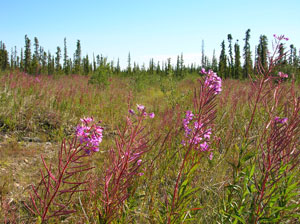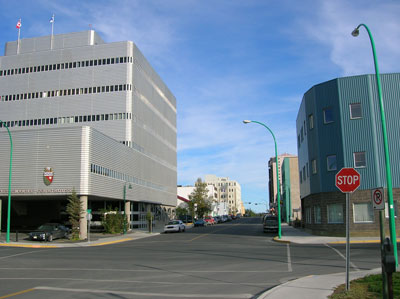 |
The day dawns cloudy and rainy but by 7 it has begun to lighten and I feel the need to get out before our 8 AM breakfast meeting. In a little scrubby patch across from the high school I find my first Blackpoll Warbler of the day--yet another scruffy bird, apparently a bird of the year with a three-quarter length tail but clearly already migrating. I walk further, past a 10-story apartment building and a residential suburb like any you might see in Canada or the U.S., and down to the lakeshore. Another small flock of migrants is moving through the vegetation around the houses and, after a few minutes of pishing, they come in closer--another Blackpoll Warbler, 2 Tennessee Warblers, 3 Yellow Warblers, and a Ruby-crowned Kinglet. A Common Loon calls from the lake nearby. A man walking down the street sees my binoculars and asks what I am looking for. He is surprised to hear that there are so many birds nearby but at least he's interested--that's the first step!
Herring, Ring-billed, and California Gulls are scattered around various rocks and docks along the waterfront. A little further along I pish again in another little patch of alders, willows, and spruce below a striking rocky dome (there's lots around Yellowknife) and up pops an immature White-crowned Sparrow. In a few minutes in comes more Yellow Warblers, Tennessee Warblers, and an Orange-crowned Warbler. Several clearly recently fledged White-throated Sparrows peer at me nervously from within the bushes. An Empidonax flycatcher "whit"s from within the thicket and then flies into view as it feeds a juvenile--a Least Flycatcher with it bold white eyering and dumpy-body--I'm surprised as I think of this as rather north for this species but I'll have to check my field guide range maps again to see. While I am studying the flycatcher several Common Redpolls fly over.
At 8, I am at Kelee's, a little diner in the Red Roof Inn, to meet my traveling companions. First to arrive is Erica, one of the staff of the Canadian Parks and Wilderness Society working on establishing Protected Areas in the Mackenzie Valley. Erika was born and raised here in Yellowknife and has recenty returned after living in other parts of Canada. Soon we are joined by Kelly from the Canadian Boreal Initiative and journalist/writer Nick Jans who has traveled from Alaska to understand the Mackenzie Valley pipeline issues firsthand.
A further tour of Yellowknife follows including what I am told is the famous Yellowknife dump where there are lots of Common Ravens and Herring Gulls with a few California Gulls thrown in for good measure. Erika tells us that the dump has been written about because of the scavenging people have always done here--a way of recycling, of eeking a little more out of everything as generations of people who have lived in these harsh northern climes have been forced to do to survive.
A little further along is the now closed gold mine--the site a few years ago of labor unrest in which a striking miner set a bomb that ended up killing 12 of his fellow miners and set off a bitter fight that has continued for years. The mine is now closed but there are tons of arsenic sitting in tunnels in the ground under the town and now the federal goverment is left with the task of dealing with it.
We pick up photographer Garth at the airport--his plane was delayed last night and he had to spend the night in Edmonton--and then continue our tour. Soon we are passing Yellowknife's own big box strip. McDonalds, Kentucky Fried Chicken, and even a Walmart, are among the warehouse sized industrial-looking stores here. Kelly, who last visited about 5 years ago, points out that most of these are new since her last visit--new since diamonds were discovered and mining them turned into big business. Even frontier towns can have sprawl.
We arrive back at the Canadian Parks and Wilderness Society and Ducks Unlimited offices around 11. As we walk towards them along a "downtown" Yellowknife street, a Blackpoll Warbler drops from the sky into a birch tree in front of the bank. Sitting on top of the building across from the office are two Ring-billed Gulls and a California Gull. Erica tells me that the return of the gulls is one of the best early signs of spring here in Yellowknife--it usually means that there is some open water somewhere and warmer weather is on its way.
 |
This afternoon we will leave for the little town of Deline near Great Bear Lake where we will spend the next two days and from where it will be unlikely that I will be able to update this blog. If not, I will fill you in when I return. Deline is a town of about 600 mostly aboriginal people and this week there is a First Nations assembly underway there. We should learn much about how the pipeline project is viewed by this community. I'll let you know what we find out.
Jeff Wells
Boreal Songbird Initiative
(from Yellowknife)

